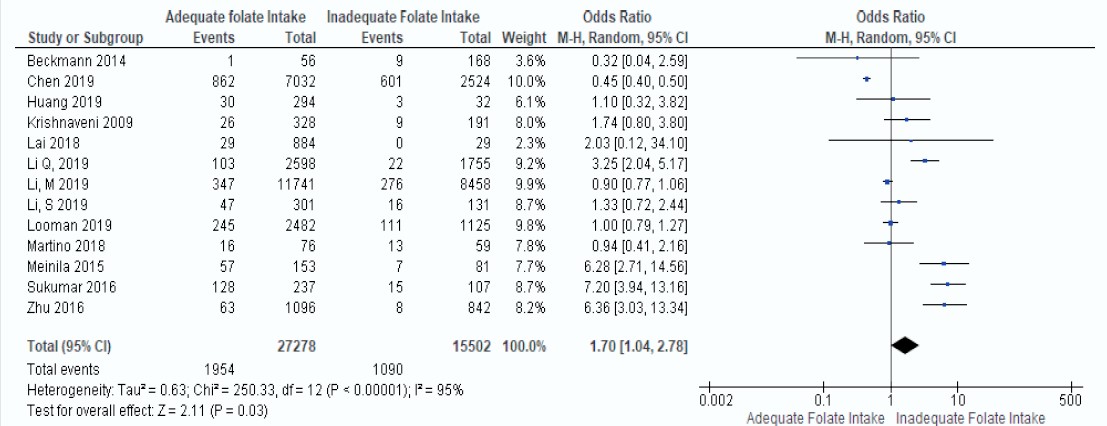
Gestational diabetes mellitus (GDM) is a common pregnancy complication that can lead to issues like macrosomia, premature birth, and difficult labor. Understanding the connection between folate and GDM is essential for expectant mothers.
Research Insights
To delve into this relationship, researchers conducted systematic reviews
and meta-analyses, drawing data from authoritative databases like PubMed,
EMBASE, and Clinical Trials.gov.
They analyzed 13 observational studies involving 42,780 pregnant women, focusing on their folate intake before and during pregnancy, as well as the incidence of GDM.

The findings revealed that women who consumed high doses of folate (>400 μg/day for over 90 days) had a 70% higher risk of developing GDM in the mid-to-late stages of pregnancy compared to those who took lower doses (<400 μg/day for less than 30 days).

This discovery has prompted a reevaluation of folate intake recommendations during pregnancy.
Balancing Folate Intake
Experts emphasize that while folate is indispensable for preventing neural tube defects, its intake should be carefully managed. Excessive consumption of synthetic folic acid may elevate the risk of GDM, potentially harming both the mother and the fetus.

Therefore, expectant mothers are advised to plan their folate intake thoughtfully to safeguard maternal and fetal health.
Folate Metabolism and GDM Risk
Research indicates that an overabundance of synthetic folic acid can inhibit methylenetetrahydrofolate reductase (MTHFR), disrupting one-carbon metabolism and homocysteine (HCY) levels.

MTHFR is a key enzyme in folate metabolism, and its reduced activity can lead to increased homocysteine levels. Elevated homocysteine is linked to oxidative stress, cell apoptosis, and insulin resistance—all potential contributors to GDM.
Advantages of 6S-5-Methyltetrahydropteroic Acid
In response to these risks, researchers have explored safer and more effective folate supplements. They have developed 6S-5-methyltetrahydropteroic acid, which represents the final form of synthetic folic acid metabolism in the body and constitutes 98% of the body's folate. Unlike synthetic folic acid, 6S-5-methyltetrahydropteroic acid (5-MTHF) is directly absorbed without the need for metabolism. It also aids in homocysteine metabolism, helping to lower levels and reduce the risk of cardiovascular diseases, making it a superior supplement option.

Expectant mothers should not only focus on choosing a safer folate supplement but also prioritize other health aspects. A balanced diet is fundamental, providing essential nutrients like protein, vitamins, and minerals to support pregnancy and fetal development. Moderate exercise enhances physical fitness, eases pregnancy discomfort, and helps manage weight gain, thereby reducing the risk of complications like GDM. Regular check-ups are crucial for early detection and management of potential health issues, ensuring the well-being of both mother and child.

By integrating scientific folate supplementation with a balanced diet, moderate exercise, and regular check-ups, comprehensive care for maternal and fetal health can be achieved.
Conclusion
In summary, it's crucial to supplement folate intake during pregnancy in a scientific and balanced manner. While synthetic folic acid is beneficial for preventing neural tube defects, excessive intake may increase GDM risk. Expectant mothers are encouraged to opt for safer supplements like 6S-5-methyltetrahydropteroic acid, especially Naturalization folate (Magnafolate), and to adopt a holistic health approach that includes a balanced diet, moderate exercise, and regular check-ups.

Wishing all expectant mothers a healthy and joyful pregnancy journey, culminating in the arrival of a new life!
References:
1. Sarker, P., Joabe, A., Sarker, S., Jiayue, Z., & Hongzhuan, T. Association between Folic Acid and Gestational Diabetes Mellitus: A Systematic Review and Meta-Analysis. 2021. Diabetes Management, 11(2), 186-195.
2. Williamson, J.M.; Arthurs, A.L.; Smith, M.D.; Roberts, C.T.; Jankovic-Karasoulos, T. High Folate, Perturbed One-Carbon Metabolism and Gestational Diabetes Mellitus. Nutrients. 2022, 14, 3930.
3. Wang, S.W., Zhang, Q.Z., Zhang, T., & Wang, L. Research Progress on the Prevention of Folate Deficiency by 5-Methyltetrahydropteroic Acid. International Journal of Pediatrics, 2020, 47(10): 723-726.
4. Pietrzik K, Bailey L, Shane B. Folic Acid and L-5-Methyltetrahydrofolate Comparison of Clinical Pharmacokinetics and Pharmacodynamics. Clin Pharmacokinet. 2010;49(8):535-548.
5. Lian, Z.L., Liu, K., Gu, J.H., Cheng, Y.Z., et al. Biological Characteristics and Applications of Folate and 5-Methyltetrahydropteroic Acid. Chinese Food Additives, 2022, Issue 2.
#L-Methylfolate#5-MTHF#folate#L-5-methyltetrahydrofolate calcium#SSW#Magnafolate#151533-22-1#active folate#pregestational hypertension#HCY#homocysteine#gestational hypertension#PIH#pre-eclampsia#gestational diabetes

 Español
Español Português
Português  русский
русский  Français
Français  日本語
日本語  Deutsch
Deutsch  tiếng Việt
tiếng Việt  Italiano
Italiano  Nederlands
Nederlands  ภาษาไทย
ภาษาไทย  Polski
Polski  한국어
한국어  Svenska
Svenska  magyar
magyar  Malay
Malay  বাংলা ভাষার
বাংলা ভাষার  Dansk
Dansk  Suomi
Suomi  हिन्दी
हिन्दी  Pilipino
Pilipino  Türkçe
Türkçe  Gaeilge
Gaeilge  العربية
العربية  Indonesia
Indonesia  Norsk
Norsk  تمل
تمل  český
český  ελληνικά
ελληνικά  український
український  Javanese
Javanese  فارسی
فارسی  தமிழ்
தமிழ்  తెలుగు
తెలుగు  नेपाली
नेपाली  Burmese
Burmese  български
български  ລາວ
ລາວ  Latine
Latine  Қазақша
Қазақша  Euskal
Euskal  Azərbaycan
Azərbaycan  Slovenský jazyk
Slovenský jazyk  Македонски
Македонски  Lietuvos
Lietuvos  Eesti Keel
Eesti Keel  Română
Română  Slovenski
Slovenski  मराठी
मराठी  Srpski језик
Srpski језик 








 Online Service
Online Service